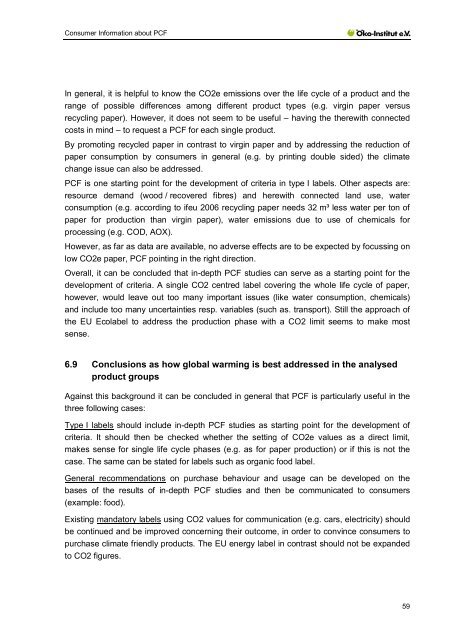Requirements on Consumer Information about Product ... - ANEC
Requirements on Consumer Information about Product ... - ANEC
Requirements on Consumer Information about Product ... - ANEC
Create successful ePaper yourself
Turn your PDF publications into a flip-book with our unique Google optimized e-Paper software.
C<strong>on</strong>sumer Informati<strong>on</strong> <strong>about</strong> PCF<br />
In general, it is helpful to know the CO2e emissi<strong>on</strong>s over the life cycle of a product and the<br />
range of possible differences am<strong>on</strong>g different product types (e.g. virgin paper versus<br />
recycling paper). However, it does not seem to be useful – having the therewith c<strong>on</strong>nected<br />
costs in mind – to request a PCF for each single product.<br />
By promoting recycled paper in c<strong>on</strong>trast to virgin paper and by addressing the reducti<strong>on</strong> of<br />
paper c<strong>on</strong>sumpti<strong>on</strong> by c<strong>on</strong>sumers in general (e.g. by printing double sided) the climate<br />
change issue can also be addressed.<br />
PCF is <strong>on</strong>e starting point for the development of criteria in type I labels. Other aspects are:<br />
resource demand (wood / recovered fibres) and herewith c<strong>on</strong>nected land use, water<br />
c<strong>on</strong>sumpti<strong>on</strong> (e.g. according to ifeu 2006 recycling paper needs 32 m³ less water per t<strong>on</strong> of<br />
paper for producti<strong>on</strong> than virgin paper), water emissi<strong>on</strong>s due to use of chemicals for<br />
processing (e.g. COD, AOX).<br />
However, as far as data are available, no adverse effects are to be expected by focussing <strong>on</strong><br />
low CO2e paper, PCF pointing in the right directi<strong>on</strong>.<br />
Overall, it can be c<strong>on</strong>cluded that in-depth PCF studies can serve as a starting point for the<br />
development of criteria. A single CO2 centred label covering the whole life cycle of paper,<br />
however, would leave out too many important issues (like water c<strong>on</strong>sumpti<strong>on</strong>, chemicals)<br />
and include too many uncertainties resp. variables (such as. transport). Still the approach of<br />
the EU Ecolabel to address the producti<strong>on</strong> phase with a CO2 limit seems to make most<br />
sense.<br />
6.9 C<strong>on</strong>clusi<strong>on</strong>s as how global warming is best addressed in the analysed<br />
product groups<br />
Against this background it can be c<strong>on</strong>cluded in general that PCF is particularly useful in the<br />
three following cases:<br />
Type I labels should include in-depth PCF studies as starting point for the development of<br />
criteria. It should then be checked whether the setting of CO2e values as a direct limit,<br />
makes sense for single life cycle phases (e.g. as for paper producti<strong>on</strong>) or if this is not the<br />
case. The same can be stated for labels such as organic food label.<br />
General recommendati<strong>on</strong>s <strong>on</strong> purchase behaviour and usage can be developed <strong>on</strong> the<br />
bases of the results of in-depth PCF studies and then be communicated to c<strong>on</strong>sumers<br />
(example: food).<br />
Existing mandatory labels using CO2 values for communicati<strong>on</strong> (e.g. cars, electricity) should<br />
be c<strong>on</strong>tinued and be improved c<strong>on</strong>cerning their outcome, in order to c<strong>on</strong>vince c<strong>on</strong>sumers to<br />
purchase climate friendly products. The EU energy label in c<strong>on</strong>trast should not be expanded<br />
to CO2 figures.<br />
59
















